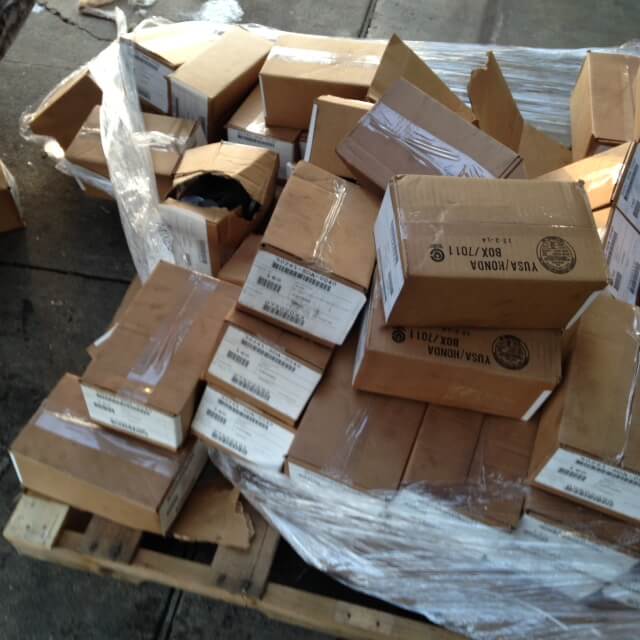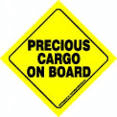Looking Both Ways

All About Cargo
All About Cargo
This post of Looking Both Ways will take a look at Cargo. Many of you have hauled all kinds of freight and have also most likely moved some pretty interesting loads. Transporting the cargo or the load is how all of us in this industry make our living. Without the cargo, we all would be without a paycheck. We can then all agree that the cargo we transport could be considered precious or valuable in many ways. I want to help you think more about the precious cargo you are transporting. The extra thought may save you and your carrier headache and money. Here are some things to consider.
Before you begin any load or shipment:
• Is your vehicle cargo box able to safely accommodate the cargo? (Example: paper products)
o Floor able to haul the weight
o Floor condition
o No leaks through floor?
o Doors sealing properly?
o Is the cargo safe and protected from possible water damage?
• Is your vehicle equipped with more than adequate numbers of straps, load lock bars, blankets, and other load securement or protection devices?
• Are all mechanical components of your vehicle is proper operating condition?
• Are you required to comply with Part 393 of FMCSR?
o If you operate a commercial motor vehicle as defined in Sec. 390.5:
GVW, GVWR, GCW or GCWR of 10,001 pounds or more;
Transporting hazardous materials that require the vehicle to be placarded
Passenger provisions not addressed for our purposes
• Read and become familiar with the Driver Manual given to you by your carrier. Chances are there is a section on Cargo Securement contained in that book.
At the shipper:
• Think about where you are picking up – could this type of facility deal with high value freight?
• If it is high dollar fright – a quick call to your dispatch can help verify that the freight is covered by the levels of your insurance.
• Are there any special instructions noted on the Bill of Lading for transporting this freight?
• Oversee the loading or unloading of your vehicle.
• Does the Bill of Lading correctly list and describe the product?
• Check the identity, condition, and count of every load.
• Is the product packaged in a suitable manner to be transported by highway truck?
• Are bands broken, are skids broken?
• Is other packaging damaged or show signs of potential damage?
• Is there pre-existing damage to the cargo?
• Wheeled products – do you have the product really secured to keep it from rolling?
• What would happen with this freight if you had to make a sudden stop – a deer, cut off by another vehicle, accident?
• If transporting glass (like windshields) is it packaged appropriately for shipping? Is there sufficient protection to endure the stress of bumps, pot holes and other road hazards?
• Should the load be wrapped with blankets?
• Load compatibility issues (Hazardous materials or food grade products)
• Does the shipment possibly contain hazardous materials?
• Do you have the correct endorsement to transport the cargo (hazmat or tanker)
• Should the trailer or cargo box be vented?
• Secure every load using load lock bars, straps, nailing a 2x4, or whatever it takes to protect the cargo from damage.
• NO LOAD SHOULD EVER BE TRANSPORTED WITHOUT BEING PROPERLY SECURED - It is your job to secure each and every load you haul.
• Is the cargo to be transported by Air at some point? Be sure to follow IAC guidelines.
• Passing through Canada as part of an "In Bond" movement? - Be sure to complete appropriate customs paperwork and leave customs seals intact on cargo container (box or trailer)
• Did you leave the shipper confident their cargo will be well cared for with you?
• Understand the Regulations. See 49CFR 392.9 https://www.law.cornell.edu/cfr/text/49/392.9
• Complete load securement by applying approved padlock to cargo box.
• Use a securement seal if required.
In Transit or While Loaded:
• Will this load being transferred from your truck during this shipment? – If so be sure to document condition and count at time of transfer – to another truck or to a warehouse type facility.
• Breakdowns – communicate with your dispatch immediately and follow their instructions.
• Accident and accident with tow – communicate with your dispatch immediately following their instructions.
• Unforeseen delays such as other accidents, construction, detours or acts of Mother Nature – communicate delays immediately to your dispatch.
• If transporting high dollar freight try to drive 200 to 250 miles after leaving the shipper without stopping. This may deter potential cargo thieves.
• Always do a security check walk around the vehicle after every stop.
• Report any suspicious activity to your dispatch or police. Better safe than sorry.
• Protect yourself from hijacking.

Stopping and Leaving a Loaded Vehicle Unattended:
Rule #1 – Never leave a loaded vehicle unattended!
• Communicate to dispatch any issue which causes you to violate Rule #1 above PRIOR to violating Rule #1 above. Follow the instructions of your dispatch.
• Only in emergency leave loaded trailer or truck in a locked, secured, fenced, well-lit parking facility and only after your dispatch has advised you where, when, why, and how to do so.
• Lock the cargo box at all times
• Use a high quality king pin lock on trailer
• Back trailer against a fixed object (building to prevent doors from being opened)
• WWSDD – what would your safety director do?
At the Consignee:
• Did you obtain a POD (Proof of Delivery) at the consignee stating that the items were "Received in Good Order"?
• If the cargo was damaged in transit or loading/unloading, did you immediately notify your carrier?
• If damaged, did you file an "incident report" with the consignee?
• If damaged, did you photograph the damaged cargo by taking numerous pictures?
• If damaged, are you the driver responsible for an insurance deductible?
• Did you leave the consignee feeling confident their cargo was well cared for by you and that they had a very positive experience with you and your carrier?
The Carmack Amendment places most cargo liability on the Carrier in interstate shipments. Liability for cargo can exceed the limits of the carrier's insurance. Negligence may not even need be proven. Some nice easy to read and understand info on the Carmack Amendment can be found at http://www.hni.com/blog/bid/84213/FAQs-About-the-Carmack-Amendment
You should now have a much better understanding how and why to protect the cargo you transport.
Disclaimer: This blog is NOT intended to give legal advice, nor be a substitute for any training required by the Regulations.
Till the next blog, Thank you drivers for all you do! Please be safe!
John Mueller, CDS, COSS
[email protected]
www.PTLLLC.com
